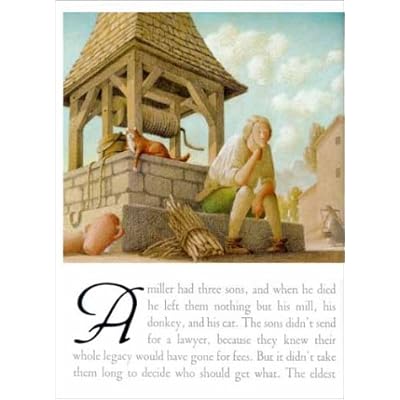
Author: Perrault, Charles
Illustrator: Marcellino, Fred
Publisher and Date: Michael di Capua Books, 1990
Genre: Traditional Literature, Picture Book
Age Range: 1st-3rd Grades
Awards: Caldecott Honor Book 1991
Summary: In this traditional tale a cat is left to the youngest of three sons after the passing of the father. The son considers killing the cat to eat and use it's fur to make a muff. The cat did not like this idea and convinced its owner to get him a pair of boots and a sack. The cat catches animals in the sack and takes them to the King to impress him. One day as the King was riding in his carriage, he rode by the river where the cat and his owner (Marquis of Carabas) were going for a swim. The cat tells the King his owner is drowning and is without clothes so the King has Marquis of Carabas rescued and clothed and he rides with the King. Puss goes ahead of the carriage and threatens peasants mowing a meadow and some harvesters into telling the King when he came by that Marquis of Carabas owned the land and crops. Puss also tricks the Ogre into turning into a mouse and eating him so that Marquis of Carabas could claim his castle as well. The King is impressed by Marquis of Carabas' large estate and takes the Kings daughter as his wife while Puss lives in luxury.
Response: I had never read the tale of Puss in Boots before. All I knew was from Shrek 2 and I am not a big fan of the Shrek movies, so even my knowledge of that was rather limited. I am not really sure what I expected from the story but I feel like the story turned out to be very different from what I might have anticipated. I was kind of confused at the beginning as to why the miller's youngest son was not shocked that the cat could talk.
I loved how Marcellino portrayed the characters in his illustrations. One of my favorite spreads in the book is the very first opening pages. This is where the youngest son is talking about killing his cat to eat it and make a muff out of the fur. The cat is sitting behind the son on the well and the expression on its face is so funny! I can honestly say it made me laugh. Its as if you can tell the cat is trying to come up with a clever plan so he won't be dinner for his owner. I think Marcellino also does a good job with keeping the illustrations relative to the time period, especially with the clothing styles.

Teaching Ideas: Use this book in comparison to another version of the same tale. Introduce Venn Diagrams and have the children participate in deciding which parts go along with this book and which go along with the next which is in the blog above this. [Pictures of Venn Diagram are also above.]


No comments:
Post a Comment